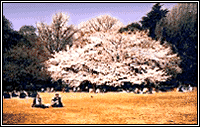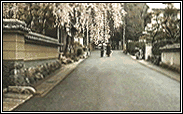
|

|
|
tokyo - scott mason
The Disposable Cherry Tree The gardener kneels with a stack of something that looks like grass sod to his left. He begins replacing the little squares of moist green moss. "I have to do this every year; the old stuff goes bad. It's the environment, you know." I've never wanted to get someone fired before, but these days I am actively campaigning for the dismissal of my landlord's gardener. Either the man goes or my most cherished tree is going to die. It's April, and Japan is in the midst of the yearly cherry blossom madness. I had read once that the Japanese let workers out of the factories to enjoy the cherry blossoms. Thinking Japan was the place for me, I rented a cottage on the grounds of an old Kyoto garden estate, adjacent to one of the great temples, in an area famous for its hundreds of flowering cherry trees. We have a number of large, old trees here on the estate. My favorite, a massive tree with late-appearing, puffy white clusters of blossoms, has been looking very poorly in the last few years. Since our gardener never touches it (or any of the other flowering trees), I decide to check with another gardener who works on a very famous tree (it's been on NHK, the sure sign of tree success) in the area. The youngish gardener in pressed khakis pauses for a moment, holstering his hand-forged pruning shears. "How old is your gardener?" he asks. "I thought so. Those guys over fifty don't know the science part. They don't understand what's happening in the environment. And they don't like to climb way up in these trees. It's not like the old days now. You cannot just leave a tree alone." The story unfolds that in the present urban environment, the cherry tree has become quite vulnerable to pollutants in the air and to acid rain. The trees gradually weaken and become hosts for borers and infections. The older generation of gardeners is still living in the past. The young gardener takes a look at my tree. "It's like cancer -- you can cure it, but you have to get in there quick. Cut out the bad parts and back into the living wood, or else it will spread." He goes on to explain the pains he takes in neatly trimming off every little piece of deadwood and painting the live ends with antiseptic ointment. The tree under his care gets this kind of treatment several times a year. Plus lots of fertilizer. "A big tree gets over 100 kilos of fertilizer per year." Excess moss and fungi are scaled off the trunks. All told, the maintenance bill for one mature tree will approach $1500 per year. That kind of money is an entire year's budget for a smallish garden. There's a serious economic aspect of having trees--if you have a spectacular-looking tree in Kyoto these days, you have an on-the-ball gardener and you are shelling out for it. I began to see the enormous maintenance problem that these trees represent. I also began to notice 18-inch trunks from trees that had been cut and swept off to the side in the area. Really worried about the situation with our big tree, I asked the caretaker to urgently convey the gardener's analysis to the absentee owner, who lives in Yokohama. I wasn't hopeful, however, and not because of the expense involved. The next time the owner showed up on the estate, the answer was clear: "The old gardener has been working on this garden for 25 years. We can't just bring somebody else in to work on these trees. We'll have to see if he can do it." In Kyoto, you just don't fire somebody after years of loyal service. A few days later, there was some lackadaisical pruning of what could be reached from the ground. Limbs were broken off at convenient places, not cut back cleanly and dosed with medicine. This was a year ago. Nothing has been done since then. The other day a different tree in our main garden fell, uprooted. I hope this loss is a shocking message to the owner that he's about to lose all his cherry trees unless he gets some specialists in here. Before that big tree falls on my cottage!
Kyoto is heavily planted in two flamboyant species: cherry and maple. It is entirely possible to get tired of the sight of them at certain times of the year. One reason for the massive numbers of trees is that they are moneymakers, media stars -- especially the cherries. Historically, having a famous tree has been a way to attract capital: temples and districts would come to be patronized as a result of the fame of their trees. Today the temples draw enormous masses of people, who pay up to $8 a head to enter the grounds, enjoy the trees, maybe find a spot to carouse and sing karaoke. Any place with more than a few trees is going to be hard pressed to provide the proper level of maintenance as outlined above unless they make it a priority. Trees get neglected, and the result is dead trees. They must soon be replaced. This is why one will see a row of fat old trees dotted with the spindly stems of young replacements. It's a sad loss to see very old trees that have been loved and cared for for generations suddenly succumb. The new attitude may be that it is cheaper to replace than to maintain: the disposable garden. Scott Mason participates at Electric Minds as kamenr. |
higa said: From one side of the coin, the education here is too restrictive, repetitive, and rote. But... you do actually learn the basics, you learn more group skills, and the education is uniform throughout the country. I also think the 'must get into Todai' pressure is starting to break down and students are pursuing more diverse futures than the one path of old. I'll be faced with the decision of whether to send my son to international school or Japanese school much sooner than I'd like. I'm not sure which way I lean. I like the rigor of Japanese school but also want Jasper to enjoy the freedom of US schools. Most Active Topics: Topic 44 Wildlife Topic 4 Tokyo wire. Topic 25 the countryside and the village | |||
|
Historically, having a famous tree has been a way to attract capital: temples and districts would come to be patronized as a result of the fame of their trees. San Francisco Cherry Blossom Festival
Cherry Blossom Weather
Forecast | ||||
Also in Tokyo: l.i.p. for electric ladies/japanese women online tokyo gadget fest geisha culture in new japan | ||||
|
|
|
electric minds |
virtual community center |
world wide jam |
edge tech |
tomorrow |
conversations
Any questions? We have answers.
©1996, 1997 electric minds, all rights reserved worldwide.
|



